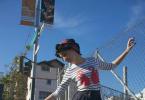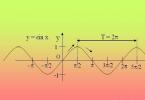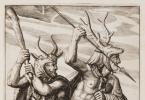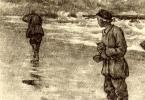Our children
Slide 1
 Slide 2
Slide 2
Repetition of the material covered: 1. Why are both bodies charged during electrification by friction? 2. Determine the sign of excess charges on the tree after the cat rubs against it. What is the sign of the charges remaining on the cat's fur?
 Slide 3
Slide 3
3. Does body weight remain unchanged during electrification? 4. Formulate the law of conservation of charge. 5. The Izvestia newspaper published the following report on March 22, 1969: “...A curious phenomenon is now being observed in Sweden... You shake hands, and suddenly an electric shock hits you; if you grab some metal object, you get another shock. What's the matter? In Scandinavia, the air is now so dry that static electricity does not leave the body, but accumulates in it in large quantities. From excessive electrification, people become more irritable and hyperexcitable.” How valid are the authors' conclusions from a physics point of view?
 Slide 4
Slide 4
In 1785, the French scientist Charles Augustin Coulomb obtained the first results of experiments on measuring the force of interaction between two point charges. To measure this force, Coulomb used a torsion balance.
 Slide 5
Slide 5
Torsion balance: Uncharged sphere Fixed charged sphere Light insulating rod Elastic thread Paper disk Scale
 Slide 6
Slide 6
A point charge is a charged body whose size is much smaller than the distance of its possible action on other bodies.
 Slide 7
Slide 7
Coulomb's law: The force of interaction between two stationary point charges located in a vacuum is directly proportional to the product of the charge modules, inversely proportional to the square of the distance between them and is directed along the straight line connecting these charges: q1 * q 2 F 12=k r2
 Slide 8
Slide 8
where: q1 q2 - magnitude of charges [C] r - distance between them [m] k - proportionality coefficient F12 - Coulomb force [N] Coulomb is an electric charge passing through the cross section of a conductor at a current strength of 1A in 1 s.
 Slide 9
Slide 9
In SI, the proportionality coefficient in Coulomb’s law is equal to: N*m2 k = 9* 109 C2 1 k = 4πε0 where ε0= 8.85*10-12C2/ (N*m2) - electric constant
 Slide 10
Slide 10
Let's consider the forces of interaction of charges: Coulomb force obeys Newton's 3rd law: F12 = F21
 Slide 11
Slide 11
The Coulomb force is central. The forces of interaction between 2 stationary point charged bodies are directed along the straight line connecting these bodies.
 Limits of applicability of the law: Charged bodies must be pointlike: the sizes of the bodies are much less than the distances between them. If the sizes and distances are commensurate, then Coulomb’s law does not apply. In this case, it is necessary to mentally “break” the body into such small volumes that each of them meets the condition of pointiness. The summation of the forces acting between the elementary volumes of charged bodies makes it possible to determine the electric force. Charged bodies must be motionless because When charged bodies move, the action of the magnetic field that arises as a result of the movement is manifested.
Limits of applicability of the law: Charged bodies must be pointlike: the sizes of the bodies are much less than the distances between them. If the sizes and distances are commensurate, then Coulomb’s law does not apply. In this case, it is necessary to mentally “break” the body into such small volumes that each of them meets the condition of pointiness. The summation of the forces acting between the elementary volumes of charged bodies makes it possible to determine the electric force. Charged bodies must be motionless because When charged bodies move, the action of the magnetic field that arises as a result of the movement is manifested.
“Electric field strength and potential” - Lesson objectives: Hint. Why does a shark quickly detect a person in the water? Why does a shark quickly detect a person who has fallen into the water? Some practical examples of the application of the basic characteristics of the electric field. Repetition. Task.
“Electric charge of the body” - About the course of general physics BONUS. Questions and passing the exam only on time, i.e. Scheduled. Theoretical question and early exam completion 751 - 850 - two!! T.2. Electricity and magnetism. 1982-1991. Larionov V.V., Veretelnik V.I., Tyurin Yu.I., Chernov I.P. Physical workshop. OF FTI TPU.
“Field potential” - Every electrostatic field is potential. All points inside the conductor have the same potential (=0). On a closed trajectory, the work done by the electrostatic field is 0. The potential value is calculated relative to the selected zero level. Energy characteristics of the electrostatic field. POTENTIAL DIFFERENCE (or otherwise VOLTAGE).
“Electrification” - Why are small pieces of paper, small pieces of foil attracted to an electrified stick? The beneficial role of electrification. Some electrons from the stick transfer to the paper. And then they bring a metal ramp closer to the plane. You're seeing electrification. Generator. Electrification. Part A is charged positively, part B is charged negatively.
“Electric field strength” - Electrical strength. field is directed towards decreasing potential. Voltage characterizes the electric field created by current. Electric field strength. Then for the electric field strength from the relations. The unit of measurement of voltage in the SI system: [U] = 1 V 1 Volt is equal to the electrical voltage at the section of the circuit where, when a charge equal to 1 C flows, work equal to 1 J is performed: 1 V = 1 J/1 C.
“Electric field charge” - In the second conductor, when moving the same charge, the electric field does 40 J of work. Coulomb’s law. Negative. There are two types of electric charges, conventionally called positive and negative. q1 + q2 + q3 + ... +qn = const. The charge of the first is +q, and the charge of the second is 0 +q +2q - q.
There are 9 presentations in total
Coulomb's law
Prepared by:
Klimanova Olga Gennadievna
Physics teacher
Municipal educational institution Zakharovskaya secondary school No. 2

- Using a physical model - a “point charge”, establish the quantitative dependence of the interaction of two stationary charged bodies located in a vacuum.

Lesson Objectives
Educational:
- to form students’ knowledge about a point charge, about the force of interaction between charges;
- show the dependence of the force of interaction between electric charges on their value and on the distance between them;
- explain the physical meaning of Coulomb's law;
- indicate the limits of applicability of the law;
- teach how to solve problems using Coulomb's law.
Educational:
- develop students’ skills to observe, analyze, generalize, compare cognitive objects, and draw conclusions;
- develop the ability to exercise self-control, self-assessment and self-correction of educational activities.
Educational:
- instill responsibility in students;
- independence.

Charles Augustin Pendant (1736-1806)
French engineer and physicist, one of the founders of electrostatics.
Invented (1784) torsion balances and discovered (1785) the law of two stationary point charged bodies.
Coulomb's experimental studies were fundamental to the formation of the doctrine of electricity and magnetism.

Point charge
Point charges are called charged bodies whose dimensions are much less than the distance between them.

Coulomb's experiment
When message the balls a And b charges of the same name, they begin to repel each other. To keep the balls at a fixed distance, the elastic wire is twisted at a certain angle. The force of interaction between the balls is determined by the angle of twist of the wire.
Torsion balances made it possible to study the dependence of the interaction force of charged balls on the values of the charges and on the distance between them.

Formulation of Coulomb's law
The force of interaction between two point charges in a vacuum is directly proportional to the product of the charge moduli and inversely proportional to the square of the distances between them.
For vacuum: ε = 1

- What does Coulomb's law define?
- How is Coulomb's law written for the interaction of charges in a vacuum?
- What quantity characterizes the influence of the environment on the force of interaction between charges?
- Write Coulomb's law for the interaction of charges taking into account the environment in the SI system?
- What is the coefficient of proportionality in Coulomb's law?
- How will the force of the Coulomb interaction of two point charges change when each charge increases by a factor of 3, if the distance between them is reduced by a factor of 2?

- With what force do two charges interact? 10 nC located at a distance 3 cm from each other?
- How far apart are the charges from each other? 1µC And 10 µC, interact with force 9mN.

Reflection
Continue the phrases:
- It was interesting to me…
- Today we figured it out...
- I realized today that...
- It was difficult for me...
- Tomorrow I want in class...

Homework
§ 87 – 88, ex. 16
Thank you for your attention!
Charles Augustin Pendant
1736 - 1806

Childhood, years of study
Charles Augustin Coulon was born on June 14, 1736 in the French city of Angoulême. His father, a government official, soon after Charles's birth moved with his family to Paris, where he briefly held a lucrative position collecting taxes.
However, he soon went broke and returned to his homeland, to the south of France, to Montpellier. Charles and his mother remained in Paris. At the end of the 1740s he
placed in one of the best schools of that time - the “College of the Four Nations”, also known as the Mazarin College.

Childhood, years of study
The level of teaching in college was quite high, and much attention was paid to mathematics. Young Charles was so carried away by the exact sciences that he resolutely opposed his mother’s intentions to choose for him the profession of a doctor, or, in extreme cases, a lawyer. The conflict has become so serious because of this
that Charles left Paris and moved to his father in Montpellier.

Military engineer
In Montpellier, back in 1706, a scientific society was founded, the second after the capital's academy. In February 1757, 21-year-old Coulomb read his first scientific work there, “Geometrical Essay on Average Proportional Curves,” and was soon elected an adjunct in the mathematics class.
But this brought only moral satisfaction; it was necessary to choose a further path. After consulting with his father, Charles chose a career as a military engineer. After
passing the exams (quite difficult, so preparing for them required nine months of classes with a teacher), Charles Coulon headed to Mézières, to the Military Engineering School, one of the best higher technical educational institutions of that time.

Military engineer
Education at the School was conducted with a practical bias: in addition to mathematics and physics, many applied disciplines were studied - from construction to labor organization issues
(students were entrusted with leading brigades of peasants mobilized for public works). Coulon graduated from the School in 1761. Although the review of him by the head of the School in some places is not at all enthusiastic (“His work on the siege is worse than average, the drawings are made very poorly, with erasures and notes... He believes that wood for gun carriages and carts can simply be found in the forest..." ), Charles Coulon was one of the best graduates.

First 10 years of service
Having received the rank of lieutenant, Charles Coulon was sent to Brest, one of the major ports on the west coast of France. In Brest, Kulon was entrusted with cartographic work related to the construction and reconstruction of fortifications on the coast. In less than two years, Coulomb
I had to turn on urgently
to work on the construction of a fortress on the island of Martinique in the West Indies to protect it from the British.

First 10 years of service
Coulomb, under whose command almost one and a half thousand people worked, was faced with many very difficult tasks. Working conditions were difficult, the climate was very difficult, there were not enough people, and even those who
remained, seriously ill. During his eight years of work on the island, Coulon himself was seriously ill eight times and subsequently returned to France with severely compromised health. The extensive experience he acquired came at a high price.

After returning home
Returning to France, Coulon received an appointment in Bouchaine in 1772. The working conditions here were much easier, and the opportunity arose to continue scientific activities again.
In 1775, the Paris Academy of Sciences announced a competitive task: “To find the best method for making magnetic needles, hanging them and checking whether their direction coincides with
direction of the magnetic meridian." The problem of the best design for a compass and the suspension of a magnetic needle fascinated Coulomb. And in 1777, Charles Coulomb became the winner of a competition dedicated to the development of an instrument for studying the Earth's magnetic field, and immediately plunged into another major work: the study of friction.

In Paris
In 1781, Coulomb's long-standing wish was fulfilled: he was transferred to Paris, where on December 12, 1781, Charles Augustin was elected academician in the class of mechanics.
In the capital, Charles Coulon was almost immediately faced with many cases, including administrative ones. Some of them had both political overtones and one of them even
ended for Coulon with a week's imprisonment in the prison of the Abbey of Saint-Germain des Pres.
However, despite the lack of time, Coulomb continues to engage in scientific activities. He formulated the laws of torsion; invented torsion balances, which he himself used to measure electric and magnetic interaction forces.

Coulomb's law
In 1784, Charles Coulomb presented his work to the Academy, a memoir about the torsion of thin metal threads, and in 1785-1789 - seven memoirs on electricity and magnetism, where he formulated
the law of interaction between electric charges and magnetic poles, later called Coulomb's law.
The experimental substantiation of Coulomb's law forms the content of the first and second memoirs. There the scientist formulates the fundamental law of electricity: “The repulsive force of two small balls, electrified
electricity of the same nature, is inversely proportional to the square of the distance between the centers of the balls.”

Personal life
Exactly when Coulomb became a family man is unclear. It is only known that the scientist’s wife Louise Françoise, née Desormeaux, was much younger than him. Their marriage was officially registered only in 1802, although Coulomb's first son, named Charles Aupostin after his father, was born in 1790. The second son, Henri Louis, was born in 1797.
By the end of 1793, the political situation in Paris became even more tense.
Therefore, Charles Coulomb decided to move away from Paris. He and his family move to his estate near Blois. Here the scientist spends almost a year and a half, escaping political storms.

Last years
Charles Coulon devoted the last years of his life to organizing a new education system in France. Traveling around the country has completely undermined my health
scientist. In the summer of 1806, he fell ill with a fever that his body could no longer cope with. Coulomb died in Paris on August 23, 1806.
Charles Coulon left a fairly significant inheritance to his wife and sons. As a sign of respect to
In memory of Coulon, both of his sons were enrolled at state expense in privileged educational institutions.
The presence of other charged bodies. Law pendant in quantum mechanics in quantum mechanics law pendant is not formulated using... quantum electrodynamics can be deduced law pendant. Law pendant, superposition principle and Maxwell's equations Law pendant and the superposition principle for electrical...
Which is much less than the distance of its possible action on other bodies. Law pendant: The force of interaction between two stationary point charges located... between them. If the sizes and distances are commensurate, then law pendant not applicable. In this case, it is necessary to mentally “break”...

Law pendant Ivanova V.N. GOU secondary school No. 280 St. Petersburg 2007 Experience pendant In experiments pendant the interaction between the balls was measured, the dimensions... of point A? Do you want to make a device yourself for demonstration? pendant law Do you want to make a device yourself for demonstration? pendant?

Law pendant Demonstration device . Description: heat a plexiglass plate, roll it up... law.

Chapter 14. Forces of electromagnetic interaction of stationary charges. Law pendant Repetition and consolidation... this task can be neglected. Based on numerous experiences Pendant

installed the following law: The forces of interaction between stationary charges are directly proportional to the product of the modules... Based on numerous experiences pendant Member of the Paris Academy of Sciences. law Point charges pendant quantitatively describes the interaction of charged bodies. Law pendant It is fundamental

by law
Law pendant, that is, established through experiment... . For the sake of the district, get to know one of the main lawів electrostatics - law pendant;

develop the knowledge and skills of developing typical... "holes are called a unit of electric charge and law pendant interactions of electric charges. Law pendant Dosled Law pendant Law pendant. Krutilny Terezi




